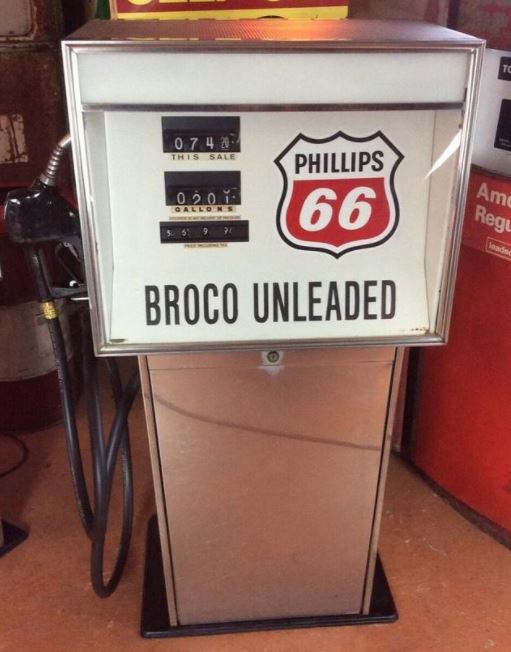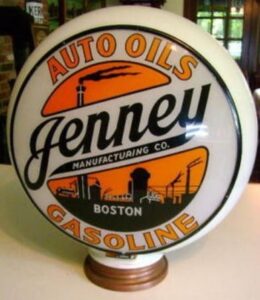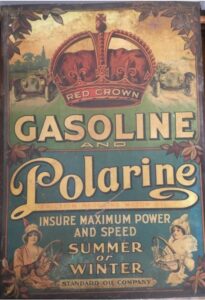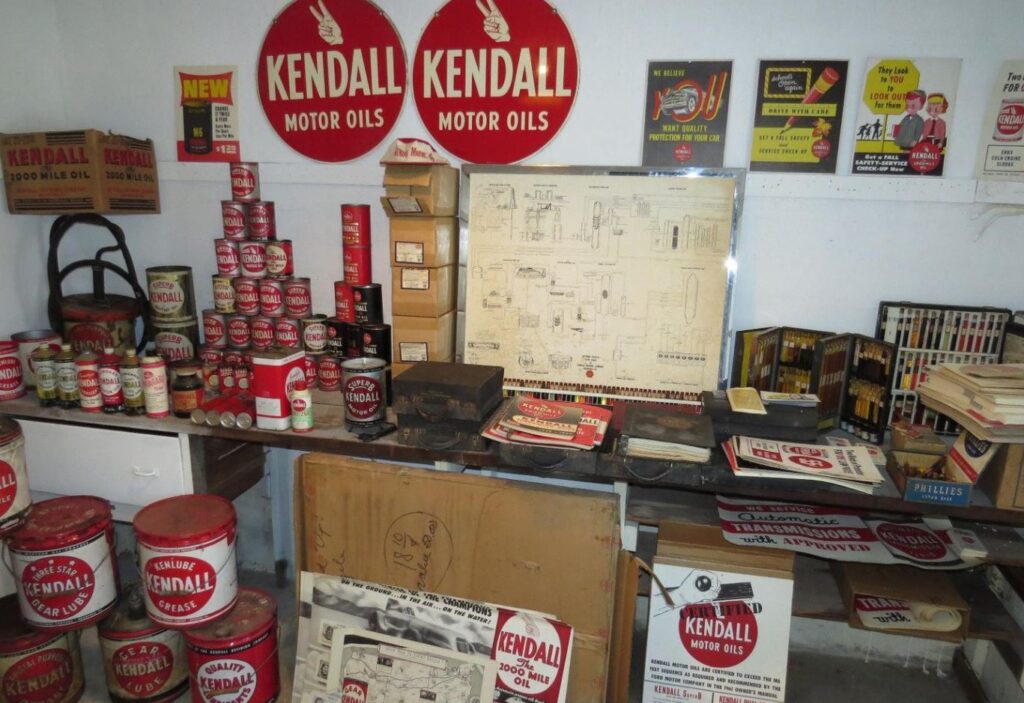Defining Automobilia and Petroliana
Automobilia and petroliana are two memorabilia-collecting categories within the automobile and gas petrol industries. Petroliana and automobilia are both words using portmanteau, known as the combining of two words. In this case, automobile, and memorabilia for automobilia. In contrast, petroliana is a combination of petroleum and Americana.
Since the first American car engine was created in 1893, it was not until the 20th Century that innovation, adaptation, and widespread usage opened a new market opportunity for the automobile and petroleum industries. This would make the automobilia and petroliana term a 20th Century phenomenon. A very modern and contemporary collector category relative to fine art and furniture, which were both credited with starting in the Hellenistic period (BC).
While a casual outsider might envision cars and gas pumps, these categories often include the ancillary segments of this market, ranging from oil cans and antifreeze to spark plugs and tires. The type of memorabilia most frequently found, but not limited to; these categories are advertising signs, gas pumps, stands, ephemera, clocks, and general car-related products, often with prominently displayed branding. Depending on the brand and the era, these can accompany vixen-like models to Native American Indians, which exhibit advertising idealisms before the inclusive culture of 21st Century America. Other common advertising themes feature subtle, America-first-type undertones of stars and stripes or blues and reds influenced by the United States flag.
Automobilia and petroliana collectibles primarily began widespread advertising in the early 20th Century, but continue today with newer, contemporary companies like Tesla. Nevertheless, the collection of historical collectibles related to the nostalgia behind automobile-based industries proves to be a subject of varied and deep interest for collectors.
Historically, related memorabilia from the 1910s to the 1930s generated most of the collector interest. However, like most markets, things change. The 1940s and 1950s have begun to shift upward in interest due to contemporary aesthetic interests, demographic shifts, and the high values placed on earlier automobilia and petroliana memorabilia, putting them out of reach for younger novice collectors.
The Invention of the Gas Pump and Rockefeller’s Standard Oil Shape the Automobile Industry

The gas station industry’s history begins with John D Rockefeller starting Standard Oil in Cleveland, Ohio, in 1870. One of the world’s original multinational corporations, the business was so successful that it drove 21 of 26 of Ohio’s refineries out of business within two years of opening. The company was forced to dissolve into multiple organizations upon the Supreme Court’s landmark 1911 ruling that Standard Oil was an illegal monopoly. Subsequently, Standard Oil was broken up into 34 competing companies that operated in different United States regions.
Gas pumps were invented in Fort Wayne, Indiana, by Sylvanus F. Bowser in 1885. Notably, the invention of the gas pump preceded the design of the modern automobile. Initially, the process of pumping gas was dangerous. However, Bowser’s progress in the gas field proved beneficial for many people. The inventor built a pump that could pull gas from a storage container, which was then released into a fuel canister and brought home to be used for home use.
Bowser sold the first kerosene pump to a grocery store owner in Indiana. As gas pump advancements continued, Bowser’s name became synonymous with his invention that gas pumps were called Bowser’s in many places throughout the world, especially at airfields. The term is sometimes still used in Australia and New Zealand. Bowser’s invention utilized a manual suction pump through which the gas flowed.
Gas Pump Designs Change as Consumer Demand, Familiarity, Automobile Ownership Expands
Ford Motor Company’s Model T was introduced in the fall of 1908. The simplistic operation and maintenance of the car allowed Ford to reduce the automobile’s cost each year. Therefore, by the early 1920s, not just the wealthy but many drivers in the United States had learned to operate the popular automobile. This popularity drove advancements in the design of filling stations and fuel pumps alike.
The earliest gas pump designs were mere advancements from the original Bowsers. They were hand crank pumps used in conjunction with the operator’s visual and audible inspection, which proved to be dangerous and inefficient. This process also left some level of skepticism about how much gas they were receiving with their purchase.
The clockface style of gas pumps began to surface by 1910. Filling stations that had not invested in the new design added on these clockfaces, but by 1915 another advancement had arrived. The visible pump, which often exceeded 9 feet in size, became the latest trend. The visible automobile gas pumps were frequently equipped with beaker-shaped glass denominating gallon measurements. These cylinders were translucent, allowing a buyer of gasoline to examine their gravity-fed pump progress and determine the clarity (purity & quality) of the gas, which was uniquely important to automobile owners.
As car ownership increased, so did the size of the roadways and the demand for gas. This competition on the space of roadways and the need for auto owners to park at filling stations led to gasoline’s underground storage. Visible gas pump cylinders quickly grew from 5-liter to 5-gallon, then the most common 10-gallon visible pump cylinders, but even 15-gallon variations exist.
By the 1920s, the branding of petrol products, logos, and bright colors of gas pumps was in full swing. The roaring ’20s had brought on a wealth of prosperity, and the sales of petrol, gasoline, and the oil lubricant industry for automobiles were booming. It has been estimated that nearly 9 million automobiles were on the road by this time. This unique economic environment coupled with modernized society standards paved the way, both literally and figuratively, for what some experts call the golden age era of petroliana and automobilia memorabilia collectibles. Incidentally, 1921 is when General Motors discovered that tetraethyl lead provided octane to gas, preventing engine knock. By the middle of the 1920s, there was 40-60 octane content in gasoline.
Visible pump style at gas stations across the United States began to wane by 1930. As money flowed heavily into the automobile and petrol industry, innovation followed. Electric pumps with art deco dials and gauges began embellishing most pumps to illustrate usage. Simultaneously, visible glass cylinders had shrunk in size and started to take a backseat in importance.
As the development of gas pumps approached 1940, the more modern square gas pump without gas visibility began to permeate the marketplace. Consumers had begun to trust that gas was being properly filtered for their motors, and the amount pumped into the automobile was appropriately measured on modern devices. Globes continued to be in use through the 1940s, but as the 1950s advanced, globes inclusion began to be traded out for better gauge illumination and modern pole lighting covering more extensive areas of service stations.
Gas Pump Innovation Timeline

1890 to 1900 – crank by-hand pumps with no measurement device, a wooden casing, and a hose
1900 to 1910 – hand crank gas pump, some with clockface (phasing in) for measurement
1910 to 1920 – hand pumps with modest and minimal color, some with clockface, and visible cylinder components begin to arrive in the latter half of this era to allow motorists to see the amount and quality of the gas they were purchasing
1920 to 1930 – visible hand pumps are prolific, colors are bolder, some with clockface, some with glowing marketing metal and glass globe on top advertising early oil companies
1930 to 1940 – art deco style with color, some with both clockface and glass cylinders, metal, and glass globe light on top
1940 to 1950 – tall rectangle styling with round edges, electronic with clock face and cylinder, some with small visible glass cylinders (beginning to phase out), still has glowing metal and glass globe on top
1950 to 1960 – square style, metal and glass globes began phasing out, small visible glass cylinders were sometimes replaced with metal filter canisters to foster trust in the filtration of the fuel, illuminating computerized measurement and price calculation dials became common
1960 to 1970 – box style continues with hard-edged styles often embellished with chrome while phasing out the round-edge styles, some globes still being included, glowing computerization on most
1970 to 1980 – unleaded fuels begin to be introduced, large square tops often with tapered waist and pedestal legs usually in bright logo colors matched with aluminum and chrome-trimmed bodies

The majority of die-hard petroliana collectors will often have one or more antique or vintage gas pumps in their collection. However, due to their size, delicacy, weight, and height (older gas pumps are taller than most modern ceilings), these are more difficult for the average collector to purchase, which could explain some of the lower prices since their highs in 2015 and 2016. Nevertheless, collectors of gas pumps remain, and many are quite valuable.
Petroliana Gas Pump Globes
 Gas pump globes were found on the top of gas pumps in the early 20th Century. The lighted gas globes would allow drivers from a distance to identify what maker of gasoline was at the station they were approaching. Stations were not particularly well-lit at that time, so gas globes were necessary for a motorist to identify where to stop to refuel. They also served as a sign of relief for many early automobile drivers, as they would typically be driving on long country roads for great distances. To see a gas globe or fuel station was a sign of civilization. Towards the 1960s, gas globes became less prevalent.
Gas pump globes were found on the top of gas pumps in the early 20th Century. The lighted gas globes would allow drivers from a distance to identify what maker of gasoline was at the station they were approaching. Stations were not particularly well-lit at that time, so gas globes were necessary for a motorist to identify where to stop to refuel. They also served as a sign of relief for many early automobile drivers, as they would typically be driving on long country roads for great distances. To see a gas globe or fuel station was a sign of civilization. Towards the 1960s, gas globes became less prevalent.
Gas globes are essentially convex glass signs that advertised a gas brand surrounded by a channeled steel-fitted body painted in a complementary color. Most of these gas pump globes are 13.5″ & 15″ lenses. However, larger variations of glass globes can be found in the collector’s market. The most common of these larger globes are the seashell molded milk glass globes with Shell in red lettering, which are often 18.5″ but lack the steel body. Gas globes are a common collectible in the petroliana field. They are small, transportable, and easy to slide into any man cave or mid-century collection.
Porcelain Sign Advertising
 Porcelain was first applied to steel in Austria and Germany around 1850. However, this porcelain application process did not arrive in the United States until the 1890s. It was called vitreous enamel or porcelain enamel. Here in the United States, we often refer to some of the nicest of petroliana and automobilia signs as porcelain. Porcelain signs began being produced in the United States for advertising around 1900. This quickly became the advertising standard for the petrol, oil, lubricant, and automobile industries. It was a tough, resilient material holding color much better than other options during this era.
Porcelain was first applied to steel in Austria and Germany around 1850. However, this porcelain application process did not arrive in the United States until the 1890s. It was called vitreous enamel or porcelain enamel. Here in the United States, we often refer to some of the nicest of petroliana and automobilia signs as porcelain. Porcelain signs began being produced in the United States for advertising around 1900. This quickly became the advertising standard for the petrol, oil, lubricant, and automobile industries. It was a tough, resilient material holding color much better than other options during this era.
By the end of World War II (1939-1945), porcelain advertising signs had nearly disappeared. The scrap drive for the war in 1942 ended the use of the materials that porcelain enamel was applied to. Therefore, manufacturers moved into other methods of producing signs, mostly paint. Today, porcelain signs, particularly new and old stock, are highly sought after and are considered some of the most prized works of art in petroliana collectibles.
 Some gas stations early signs used a screen-print and stencil process for making signs. However, it was more common to produce them through a lithographic process on the tin—this process of making signs dates to about 1875. The lithograph process on a tin can be found on double-sided die-cut flange signs. Flange signs, which can be porcelain and are typically wall-mounted and stick out from the wall with a flared base allowing a passer-by to view coming or going. These signs are usually detailed and flamboyant for their age if you can find them in good condition. However, this category is filled with reproductions because similar processes are still used today.
Some gas stations early signs used a screen-print and stencil process for making signs. However, it was more common to produce them through a lithographic process on the tin—this process of making signs dates to about 1875. The lithograph process on a tin can be found on double-sided die-cut flange signs. Flange signs, which can be porcelain and are typically wall-mounted and stick out from the wall with a flared base allowing a passer-by to view coming or going. These signs are usually detailed and flamboyant for their age if you can find them in good condition. However, this category is filled with reproductions because similar processes are still used today.
You can find these enameled, painted, and printed signs in a variety of shapes and forms, including rectangles, triangles, squares, and circles, but also in die-cut unique shapes. These varying shapes and media can be found on flanges, shelving racks, clocks, neon signs, and curb signs, sometimes called lollipops. They may be self-based, countertop, wall-mounted, or hanging from a wall or ceiling. The pre-digital advertising era was nearly limitless in how they chose to get in front of their consumers. This category of collecting is also continually active in that size, weight, durability, and visual versatility allow many collectors to enter this area of the petroliana and automobilia market.
Where is Automobilia and Petroliana Collecting Heading?
In summary, automobilia and petroliana categories are the advertising and marketing signs, stands, ephemera, and general products, often with prominent logos displayed. These can also include smaller, less obvious items like thermometers, boxes, patches, belt buckles, hats, welcome mats, plaques, ashtrays, road maps, toys, manuals, lighters, oil cans, and many other types of advertising memorabilia. Understanding how these products played a part in manufacturing, selling, and repairing the growth of transportation in America is essential as an appraiser.
In the early days, this area of America’s growth with filled with exploration and development. Thousands of companies competed in advertising their brand, many specific to certain regions of the nation. Automobiles have shaped the development and growth of the entire planet and are fundamental to the American people’s national identity. Car culture, which permeated the United States in the early to mid-20th Century, has grown into a full-fledged memorabilia market that finds itself sold at auction houses.
Collecting automobilia and petroliana is ever-growing, with many auction houses and dealers worldwide selling these to collectors. These items are an exciting addition to any aficionado of automobile history. From gas pumps to model cars, the field is rife with fascinating snapshots of history that will nostalgically inspire and delight lovers of cars and the petrol industry that kept them moving.

Do you have an automobilia or petroliana collectible or entire collection that you want to have appraised? We have performed insurance coverage, insurance claims, and IRS estate tax appraisals for personal property in this category of collecting. Consider Art of Estates, a midwest-based, multi-location, traveling appraisal firm for your valuation.
Text researched and written by Art of Estates, personal property appraisers. Photograph examples of gas pumps, signs, and old gas stations were collected from independent online sellers through sales non-public sales comparable databases. Photos of gas pump styles over time are from Safe Rack and the American Oil & Gas Historical Society (AOGHS).
Below, you can find a plastic ring replacement for your gas pump globe, however, to preserve value, we recommend steel varieties available in the market.



